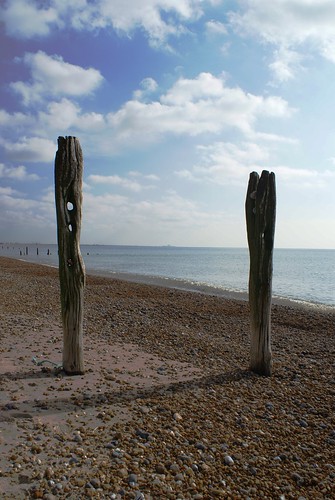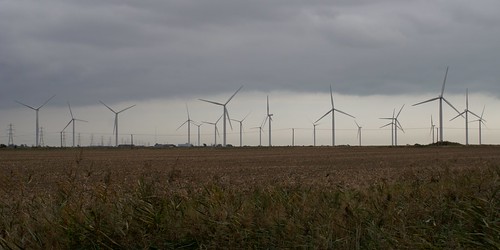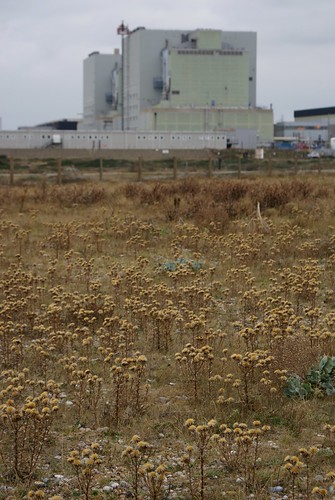
The walk took us on an almost triangular route around a protected coastal ecosystem. The foreshore was a large shingle beach, almost certainly formed by longshore drift, and clearly still on the move judging from the dilapidated groynes all along it ...

The shingle was home to a rather strange cabbage-like plant that formed irregular sparse coverage. The plants were a little desert-like in their distribution, but I couldn't think of what might be limiting them and causing this pattern. Though the SSSI was ostensibly home to a range of rare and protected species (which were nicely illustrated by mosaics), we didn't really come across much obvious wildlife. We did see more goats again, however.
Much more obvious, though distant, were two sources of power generation on the coastline. Just south of Rye we could see a large array of wind turbines, although they weren't up to much as our visit coincided with slack winds. Further off in the distance was a series of rectangular buildings that related to an altogether different carbon-free technology ...
After completing our walk (7.4 km; 4.6 mi) we headed up to the town of Rye itself. It's a nice little maze of cobbled and car-hostile streets where, somewhat to our surprise, the novelist Henry James once lived. Though small, it has its own little castle (complete with balls) and a large and well-provisioned church. After grabbing lunch at a little collective supporting adults with learning difficulties, we did a bit of exploring ...

We then headed out towards Dungeness, stopping off along the way for a closer peak at the first of the area's non-fossil fuel power sources ...

Arriving at the rather desolately beautiful Dungeness headland, our first stop was Prospect Cottage ...

This is a "cottage garden" created by the film-maker and artist Derek Jarman. Being located in the alien environment of Dungeness and rising out of the shingle there, the garden is a rather bizarre version of the rural idyll beloved of chocolate boxes (and one well-provisioned with the "sea cabbages" already mentioned). I'm guessing that's what Jarman was after when he originally created it. Well, that and locating his homage to cosy English living in the evocative and seemingly threatening shadow of Dungeness nuclear power station ...

This is the first nuclear power station that I've gotten up close to, and the setting certainly helped amp up the atmosphere. Firstly, the desolate shingle gives the area the air of a science fiction world, helped when we visited by its framing with a grey sky and sea. Secondly, the area is populated either by small cottages surrounded by junk, or simply by large piles of seeming marine debris, including beached boats and battered shipping containers. These pile on the futurism by giving Dungeness an end-of-the-world feel that wouldn't be out of place in Half-Life 2.
Surprisingly, but at the same time not surprisingly, the area is host to a small community of artists, of which Jarman was once part (he may even have been in the vanguard, but I suspect not). While investigating the displayed works of one painter (Paddy Hamilton, we later discovered), we were invited into his studio and got the low-down on his work and inspiration. One of his series of paintings was of the vehicles that visited Dungeness. It transpired that these belong to a population of transients attracted to the cheap living and isolation of the headland. The paintings themselves were interesting, but the stories behind each gave them an unexpected depth.
All that said, the power station is a pretty anodyne feature. While we were wandering around there was essentially no discernible activity or noise from the station. Quite different from the industrial landscapes around my work, which are always busy or noisy or both. In fact, what activity there was stemmed from the fair number of curious visitors who'd travelled to the tip of the headland to see the reactor buildings. Perhaps because they didn't glow, but just invisibly and silently produced power, people tended not to stay very long, and neither did we. A flurry of photographs, and we headed back inland to Burwash.
Full set of photographs available here.









No comments:
Post a Comment